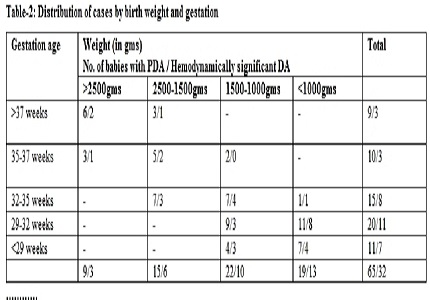Patent ductus arteriosus – clinical profile and outcome after treatment in a tertiary care hospital
Abstract
Background: Patent ductus arteriosus (PDA) is the commonest congenital heart disease seen in neonatal ICU.
Methods: A prospective observational study was conducted in the neonatal intensive care unit of Vydehi institute of medical sciences between January 2013 to December 2016. Neonates suspected to have congenital heart disease in the NICU on the basis of history clinical examination, pulse oximetry, chest X ray were included in the study and confirmed by 2D echocardiography and colour Doppler study. PDA if found hemodynamically significant treated with a three-day course of Ibubrufen and data analyzed.
Results: A total of 2658 cases were admitted in the NICU during the study period of which 1974 cases were screened for CHDs. Out of 1974 babies, Echo done showed 65 babies had PDA. Out of 65 cases with PDA 32 were hemodynamically significant. About 25 out of 32 cases had responded to treatment with Ibubrufen. Ductus were closed in 5 out of 9 large PDAs. About 48% of the PDAs were closed by 5th day of starting the treatment.
Conclusion: The study shows PDA is a commonest Acyanotic CHD in NICU and early administration of the drug is helpful in closure, avoiding surgical correction later and also mortality.
Downloads
References
2. Koch J, Hensley G, Roy L, Brown S, Ramaciotti C, Rosenfeld CR. Prevalence of spontaneous closure of the ductus arteriosus in neonates at a birth weight of 1000 grams or less. Pediatrics. 2006 Apr;117(4):1113-21.
3. Hussain S, Sabir MU, Afzal M, Asghar I. Incidence of congenital heart disease among neonates in a neonatal unit of a tertiary care hospital. J Pak Med Assoc. 2014 Feb;64(2):175-8.
4. Heymann MA, Rudolph AM, Silverman NH. Closure of the ductus arteriosus in premature infants by inhibition of prostaglandin synthesis. N Engl J Med. 1976 Sep 2;295(10):530-3.
5. Wren C, Richmond S, Donaldson L. Presentation of congenital heart disease in infancy: implications for routine examination. Arch Dis Child Fetal Neonatal Ed. 1999 Jan;80(1):F49-53.
6. Fatema NN, Chowdhury RB, Chowdhury L. Incidence of congenital heart disease among hospital live births in a tertiary hospital of Bangladesh. Cadiovasc J 2008 Mar; 1: 14-20.
7. Hoffman JI, Kaplan S. The incidence of congenital heart disease. J Am Coll Cardiol. 2002 Jun 19;39(12):1890-900. [PubMed]
8. Yang XY, Li XF, Lü XD, Liu YL. Incidence of congenital heart disease in Beijing, China. Chin Med J (Engl). 2009 May 20;122(10):1128-32. [PubMed]
9. Gupta A, Abqari S, Shahab T, Rabbani MU, Ali SM, Firdaus U. Profile and Clinical Spectrum of Congenital Heart Defects in NICU. Int Arch BioMed Clin Res. 2016 April;2(2):25-27.
10. Skelton R, Evans N, Smythe J. A blinded comparison of clinical and echocardiographic evaluation of the preterm infant for patent ductus arteriosus. J Paediatr Child Health. 1994;30:406- 411.
11. Hirsimaki H, Kero P, Wanne O (1990) Doppler ultrasound and clinical evaluation in detection and grading of patent ductus arteriosus in neonates. Crit Care Med 18:490–493.
12. Clyman RI, Chorne N. Patent ductus arteriosus: evidence for and against treatment. J Pediatr. 2007 Mar;150(3):216-19.
13. Popat H, Kapoor v, Travadi J.Patent Ductus Arteriosus in Infants <29 Weeks Gestation – Outcomes and Factors Affecting Closure.Indian Pediatrics.2012 Aug;49(8):615-20. [PubMed]

Copyright (c) 2017 Author (s). Published by Siddharth Health Research and Social Welfare Society

This work is licensed under a Creative Commons Attribution 4.0 International License.


 OAI - Open Archives Initiative
OAI - Open Archives Initiative


